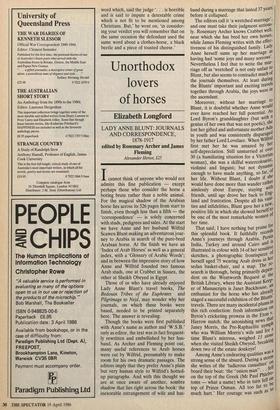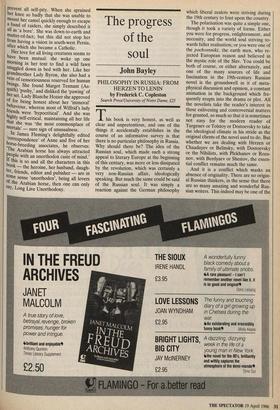Unorthodox lovers of horses
Elizabeth Longford
LADY ANNE BLUNT: JOURNALS AND CORRESPONDENCE, 1878-1917 edited by Rosemary Archer and James Fleming Alexander Heriot, £25 Icannot think of anyone who would not admire this fine publication — except perhaps those who consider the horse a boring brute rather than a noble animal. For the magical shadow of the Arabian horse lies across its 526 pages from start to finish, even though less than a fifth — the `correspondence' — is solely concerned with studs, pedigrees and sales. At the start we have Anne and her husband Wilfrid Scawen Blunt making an adventurous jour- ney to Arabia in search of the pure-bred Arabian horse. At the finish we have an `Index of Arab Horses' as well as a general index, with a 'Glossary of Arabic Words'; and in between the impressive story of how Anne and Wilfrid founded two famous Arab studs, one at Crabbet in Sussex, the other at Sheikh Obeyed in Egypt.
Those of us who have already enjoyed Lady Anne Blunt's travel books, The Bedouin Tribes of the Euphrates and Pilgrimage to Nejd, may wonder why her journals, on which these books were based, needed to be printed separately here. The answer is revealing.
Though the books were first published with Anne's name as author and 'W.S.B.' only as editor, the text was in fact frequent- ly rewritten and embellished by her hus- band. As Archer and Fleming point out, many useful references to Arab horses were cut by Wilfrid, presumably to make room for his own dramatic passages. The editors imply that they prefer Anne's plain but very human style to Wilfrid's hotted- up paragraphs. And with this thought we are at once aware of another, sombre shadow that lies right across the book: the inexorable estrangement of wife and hus- band during a marriage that lasted 37 years before it collapsed. The editors call it 'a wretched marriage', and one must take their judgment serious- ly. Rosemary Archer knows Crabbet well near which she has bred her own horses, while James Fleming writes with the effec- tiveness of his distinguished family. Lady Anne herself sums up her marriage as having had 'some joys and many sorrows'. Nevertheless I feel that to write the mar- riage off as `wretched' is not only unfair to Blunt, but also seems to contradict much of the journals themselves. At least during the Blunts' important and exciting travels together through Arabia, the joys were in the ascendant.
Moreover, without her marriage to Blunt, it is doubtful whether Anne would ever have reached her full potential. As Lord Byron's granddaughter (but with a genius of her own that was not poetic), she lost her gifted and unfortunate mother Ada in youth and was consistently disparaged by her father Lord Lovelace. When Wilfrid first met her he was amazed by her self-depreciation. Still unmarried at over 30 (a humiliating situation for a Victorian woman), she was a skilful watercolourist, violinist and linguist; but not dynamic enough to have made anything, so far, of her life. Without Blunt, I doubt if she would have done more than wander rather aimlessly about Europe, staying with friends, until age drove her back to Eng- land and frustration. Despite all his vani- ties and infidelities, Blunt gave her a new' positive life in which she showed herself to be one of the most remarkable women of her time. That said, I have nothing but praise for this splendid book. It faithfully records Anne's journeys through Arabia, Persia India, Turkey and around Cairo and is illustrated in colour with 14 of her sensitive sketches, a photographic frontispiece or herself aged 75 wearing Arab dress in her sedan basket-chair, and a map. The re- search is thorough, being primarily depen" dent on the Wentworth Bequest at the British Library, where the Assistant Keep' er of Manuscripts is Janet Backhouse, an enthusiast for the horse who has alreadY, staged a successful exhibition of the Blunts travels. There are many incidental plums 111 this rich confection: fresh information 011 Byron's cricketing prowess in the Eton Y: Harrow match; the astonishing news tha,! Janey Morris, the Pre-Raphaelite nymph who was William Morris's wife and for 3 time Blunt's mistress, weighed 13 stole when she visited Sheikh Obeyed, breaking down two of the estate donkeys! Among Anne's endearing qualities was a strong sense of the absurd. During a stain she writes of the 'ludicrous casualties'oil board their boat: `the "onion man"• • • fe on the top of the Greek (Mr Paul Phleh°; toms — what a name) who in turn fell _ top of Prince Osman. All too fat to be much hurt.' Her courage was such as to
prevent all self-pity. When she sprained her knee so badly that she was unable to mount her camel quickly enough to escape a band of raiders, she simply described it all as 'a bore'. She was down-to-earth and matter-of-fact; but this did not stop her from having a vision in south-west Persia, after which she became a Catholic.
Her love for all living creatures seems to have been mutual: she woke up one morning in her tent to find a wild fawn snuggled down in bed with her. Like her grandmother Lady Byron, she also had a vein of censoriousness reserved for human beings. She found Margot Tennant (As- quith) 'pushy,' and disliked the 'pawing' of her set. Lady Blanche Hozier she approved of for being honest about her 'immoral' behaviour whereas most of Wilfrid's lady friends were 'hypocritical'. And she was highly self-critical, maintaining all her life that she was 'the most commonplace of mortals' — sure sign of unusualness.
In James Fleming's delightfully edited correspondence' of Anne and five of her horse-breeding associates, he observes: The Arabian horse has always attracted People with an unorthodox caste of mind.' If this is so and all the characters in this book — the heroine, her husband, daugh- ter, friends, editor and pubisher — are in some sense 'unorthodox', being all lovers °f. the Arabian horse, then one can only say, Long Live Unorthodoxy.



















































 Previous page
Previous page